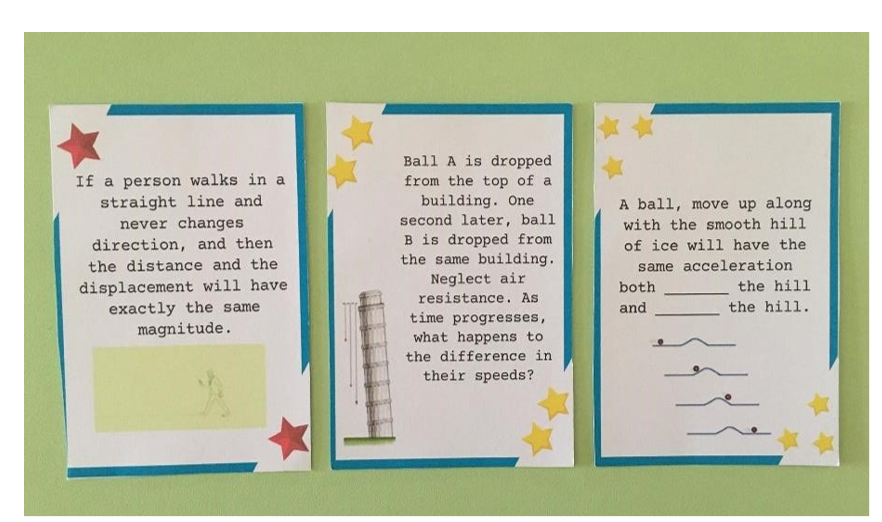Development of Card Game Flip It in Learning One Dimension Kinematics
Main Article Content
Abstract
This study is an attempt to develop a supplementary material in teaching one-dimensional kinematics through card game. The study has dual purpose of lesson supplementation and as repeatable activity for review and as alternative material for class interruptions. Provisions were assured that the contents of the curriculum were targeted in the design of the game. It was evaluated 4.81 or very good in goals and objectives; 4.83 or very good in card design; 4.7 or very good in components and organization; 4.87 or very good in playability or playfulness; and 4.77 for usefulness with an overall average of 4.8. The mean normalized gain of the sample respondents is 0.46 or medium gain. The evaluation of experts and the normalized gain of the respondents point to the viability of the card game as promising intervention material in learning one-dimension kinematics. The use of the card game can be as instructional support, as supplementary material, as review material, and as pre-lesson activity. The study concludes that learning science can be engendered in a non-sequential form like what happened in this study.
Article Details

This work is licensed under a Creative Commons Attribution-NonCommercial-NoDerivatives 4.0 International License.
References
Aguirre, J. M. (1988). “Student preconceptions about vector kinematics. Physics Teacher, 26, 212-216.
Akanbi, A. O., & Shehu, A. (2020). Influence of Time-of-Day of Instruction on the Performance of Senior School Students in Physics in Ilorin, Nigeria. Acta Didactica Napocensia, 13(1), 154-163. Retrieved October 28, 2021from https://files.eric.ed.gov/fulltext/EJ1266842.pdf
Angell, C., Guttersrud, O., Henriksen, E., & Isnes, A. (2004). Physics: Frightful, but fun. Pupils' and teachers' views of physics and physics teaching. Science Education, 88(5), 683-706. doi:10.1002/sce.10141
Ayop, S. K., & Ayop, S. K. (2019). Students’ Understanding in Kinematics: Assessments, Conceptual Difficulties and Teaching Strategies. International Journal of Academic Research in Business and Social Sciences, 9(2), 1278–1285. https://www.researchgate.net/profile/Shahrul-Kadri-Ayop/publication/336414006_Students'_Understanding_in_Kinematics_Assessments_ Conceptual_Difficulties_and_Teaching_Strategies/links/5da064a292851c6b4bcbc574/S tudents-Understanding-in-Kinematics-Assessments-Conceptual-Difficulties-andTeaching-Strategies.pdf
Beichner, R. J. (1994). Testing student interpretation of kinematics graphs. American journal of Physics, 62(8), 750-762.
Byun, T., Ha, S. & Lee, G. (2008). Identifying student difficulty in problem solving process via the frame work of the house model. Proceedings of the Physics Education Research Conference (Vol.1064, pp. 87-90). Edmonton, Alberta: AIP
Cardinot, A., & Fairfield, J. A. (2019). Game-based learning to engage students with physics and astronomy using a board game. International Journal of Game-Based Learning (IJGBL), 9(1), 42-57. https://www.researchgate.net/publication/330062584_GameBased_Learning_to_Engage_Students_With_Physics_and_Astronomy_Using_a_Board_Game DOI: 10.4018/IJGBL.2019010104
Eraikhuemen, L., & Ogumogu, A. E. (2014). An assessment of secondary school physics teachers conceptual understanding of force and motion in Edo South senatorial district. Academic Research International, 5(1), 253.
Govender, N., & Dega, B. G. (2016). Framework categorization of pre-service physics teachers’ conceptions of vector-kinematics. Journal of Baltic Science Education, 15(3), 325. Retrieved October 29, 2021 from http://www.scientiasocialis.lt/jbse/files/pdf/vol15/325-339.Govender_JBSE_Vol.15_No.3.pdf
Kamnardsiri, T., Hongsit, L. O., Khuwuthyakorn, P., & Wongta, N. (2017). The Effectiveness of the Game-Based Learning System for the Improvement of American Sign Language using Kinect. Electronic Journal of e-Learning, 15(4), pp283-296. Retrieved October 29, 2021 from https://files.eric.ed.gov/fulltext/EJ1154946.pdf
Kola, A. J. (2017). Investigating the Conceptual Understanding of Physics through an Interactive Lecture-Engagement. Cumhuriyet International Journal of Education, 6(1), 82. https://www.researchgate.net/profile/Aina-Kola-2/publication/315841723_Investigating_the_Conceptual_Understanding_of_Physics_t hrough_an_Interactive_Lecture-_Engagement/links/58eb7f914585153b60c96054/Investigating-the-Conceptual-Understanding-of-Physics-through-an-Interactive-Lecture-Engagement.pdf
Liu, E. Z. F., & Chen, P. K. (2013). The effect of game-based learning on students’ learning performance in science learning–A case of “conveyance go”. Procedia-Social and Behavioral Sciences, 103, 1044-1051. Retrieved October 28, 2021 from https://core.ac.uk/download/pdf/81980848.pdf
Mešić, V., Dervić, D., Gazibegović-Busuladžić, A., Salibašić, D., & Erceg, N. (2015). Comparing the Impact of Dynamic and Static Media on Students' Learning of OneDimensional Kinematics. Eurasia Journal of Mathematics, Science and Technology Education, 11(5), 1119-1140 Retrieved October 29, 2021 from https://www.ejmste.com/download/comparing-the-impact-of-dynamic-and-staticmedia-on-students-learning-of-one-dimensional-kinematics-4422.pdf
OECD (2009), "The Professional Development of Teachers", in Creating Effective Teaching and Learning Environments: First Results from TALIS, OECD Publishing, Paris. Retrieved October 28, 2021 from https://www.oecd.org/berlin/43541636.pdf
Sadler, P. M., & Sonnert, G. (2016). Understanding Misconceptions: Teaching and Learning in Middle School Physical Science. American Educator, 40(1), 26-32.
Schneider, L., Oliveira, D. S., Strapasson, A. C., Ferreira, B. P., Molina, C. G., Stopiglia, C. D., & Scroferneker, M. L. (2012). White blood cell game: a teaching method. International Journal of Health Promotion and Education, 50(6), 311-317.
Williams, C., Stanisstreet, M., Spall, K., Boyes, E., & Dickson, D. (2003). Why aren't secondary students interested in physics? Physics Education, 38 (4), 324-329
Yien, J. M., Hung, C. M., Hwang, G. J., & Lin, Y. C. (2011). A game-based learning approach to improving students’ learning achievements in a nutrition course. The Turkish online journal of educational technology, 10(2), 1-10.
Zirawaga, V. S., Olusanya, A. I., & Maduku, T. (2017). Gaming in education: Using games as a support tool to teach history. Journal of Education and Practice, 8(15), 55-64. Retrieved October 26, 2021from https://files.eric.ed.gov/fulltext/EJ1143830.pdf


